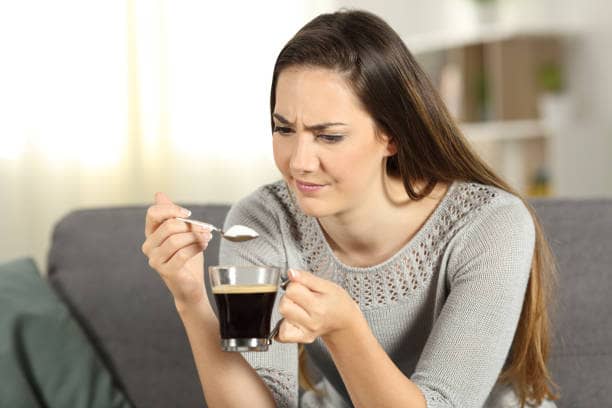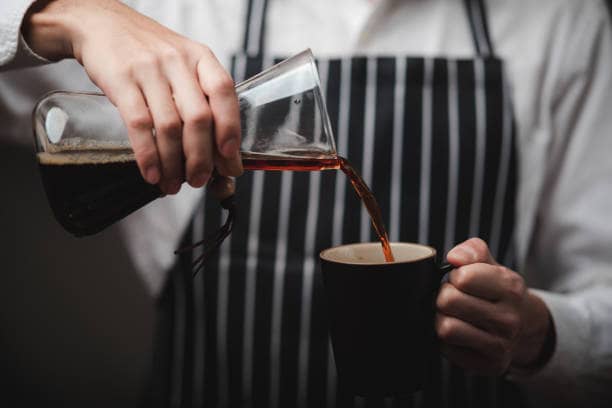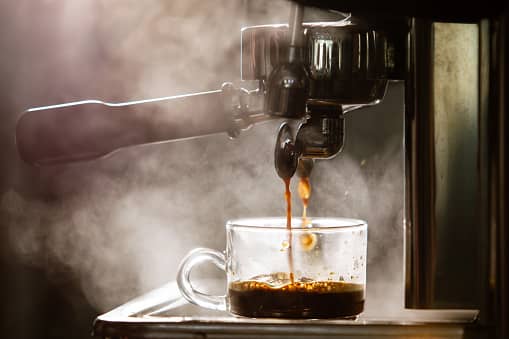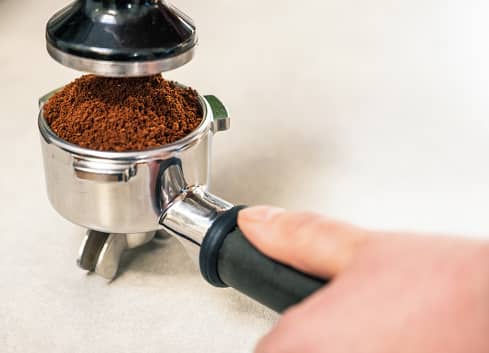Espresso is a coffee beverage made by forcing hot water under pressure through coffee beans.
The unique flavor of the espresso shot comes from the coffee beans, which are roasted and ground to a very fine consistency.
The hot water pressure extracts more of the coffee oils and flavors, resulting in a strong and concentrated drink.
However, sometimes espresso can have a sour taste, and it’s one of the most common problems that coffee drinkers face.
In this article, we’ll look at some of the most common causes of what makes espresso sour and how to find and fix it.
So, if you’re wondering why your espresso tastes sour, read on!
But let’s first discuss what makes an excellent espresso.
What makes an excellent espresso?
To understand what causes the espresso shot tastes sour, it’s important to know what makes an excellent espresso.
An excellent espresso should have a balance of sweetness, acidity, and bitterness. It should be rich and full-bodied, with a thick crema on top.
The coffee grounds play a big role in achieving this balance. They should be freshly roasted and ground to a very fine consistency.
The brewing process is also important. The water should be at the correct temperature, and the grind should be even.
Too much or too little of either can result in a sour-tasting espresso.
Lastly, the extraction process.
The coffee extraction process is the process of extracting the coffee bean’s flavor and aroma into a cup of coffee.
There are several factors that affect the coffee extraction process, including grind size, brew time, water temperature, and pressure.
The brew time is the amount of time that the water is in contact with the coffee grounds. A longer brew time will extract more flavor and aroma from the beans.
Water temperature affects the rate at which the coffee beans release their flavor and aroma. A higher water temperature will extract the flavor and aroma more quickly.
Pressure affects the rate at which water flows through the coffee grinds. Higher pressure will allow the water to flow through the grinds more quickly, extracting more flavor and aroma.
By controlling these factors, you can extract the desired amount of flavor and aroma from the coffee beans.
Now that we know what makes an excellent espresso, let’s take a look at some of the most common causes of sour espresso.
What is a sour espresso?
A sour espresso shot is a coffee that has a sour, unpleasant taste.
A sour-tasting brew can be caused by a number of different things, from ground coffee themselves to the brewing process.
Luckily, you can determine the cause of the sourness by looking at the coffee grind, the water, and the brewing method.
Common Reasons for Espresso Tasting Sour
There are several reasons espresso can turn out sour. The most common causes are:
- The coffee beans are old or stale
- The water is too hard or not at the correct temperature.
- The grind is too coarse or too fine.
- The brewing time is too long or too short.
- The tamping pressure is too high or too low.
- The espresso machine is dirty
To find the cause of your sour espresso, you have to check each of the common causes mentioned above.
Let’s take a look at each of these in more detail.
Coffee beans
Coffee beans are the most important ingredient in espresso.
If they are not good quality, the espresso will not taste good, and it can be sour.
There are a few things that can affect the quality of coffee beans, from the way they are grown to the way they are roasted.
A coffee bean can have a sour taste if they grow in an area with high acidity. The coffee plant absorbs the acid from the soil, which can give the beans a sour taste.
Coffee beans can also be affected by how they are roasted. If they are roasted for too long, they can become burnt, and this will make a bitter coffee, while a lighter roast will make the espresso taste sour.
And if the beans are not ground to a fine consistency, the espresso will be weak and sour.
Additionally, coffee beans go stale quickly after they’re roasted. And once they’re ground, they lose even more of their flavor.
If you’re using old or stale coffee beans, your espresso will likely have a sour taste.
Water quality
The water you use to brew espresso can also affect the taste.
If the water is too hard, it can make the taste of espresso sour.
Hard water contains high levels of minerals, such as calcium and magnesium.
These minerals can interact with the coffee grounds and affect the flavor.
Additionally, if the water is too hot or too cold, it can also make espresso taste sour. The ideal brewing temperature for espresso is between 195- and 205-degrees Fahrenheit.
If your water is too hard or not at the correct temperature, it can also give a sour flavor to a coffee.
Grind
The coffee grind size is also important. If the grind is too coarse, the espresso will be weak and watery.
And if the grind is too fine, the espresso can have a sour or bitter taste.
This is because the grind affects how much water interacts with the coffee grounds.
If the grind is too coarse, the water will flow through the coffee too quickly and won’t extract all of the flavors from the beans.
And if the grind is too fine, the water will interact with the coffee for too long and extract too much bitterness.
An espresso should pour only between 25-35 seconds.
Brew time
In brewing coffee, time is also important. If the espresso is brewed for too long, it will be over-extracted, and it can make your coffee taste bitter.
On the other hand, if the espresso is brewed for too short, it will be under-extracted and will result in sour espresso shots.
Ideally, espresso should be brewed for 20 to 30 seconds. An espresso shot can have a sour taste if it’s brewed in less than 20 seconds.
Tamping pressure
The tamping pressure is the amount of force you use to press the coffee grinds into the espresso machine’s filter basket.
If the tamping pressure is too little, the water will flow through the coffee too quickly, and the espresso will be weak and watery.
And if the tamping pressure is too much, the espresso will be over-extracted and taste bitter.
If you’re using a lever espresso maker, you’ll need to apply less pressure than you would with a piston machine.
If your espresso is tasting sour, try adjusting the tamping pressure and see if that makes a difference. To measure how much pressure you’re applying each time, get a tamper that has a pressure gauge attached.
If you don’t have a pressure gauge tamper, there are other ways to measure the pressure. One is to use a bathroom scale.
Tamp the coffee in the portafilter and then place it on the scale. Note the measurement and try to apply the same amount of pressure each time.
As a general rule, 30 pounds of pressure is ideal for tamping espresso. This may take some practice to get right, but once you do, you’ll be making great espresso in no time!
Cleaning your espresso machine
Dirty equipment is one of the most common causes of espresso sourness.
If the espresso maker is not cleaned properly, the coffee grounds can build up and interact with the water, resulting in a sour coffee.
It’s important to clean your espresso maker after every use.
This will prevent the build-up of coffee grounds and ensure that each shot tastes fresh.
How do you fix sour coffee?
Having a sour coffee can ruin your morning. But don’t worry, there are a few things you can do to fix it.
Here are the 6 steps to fix a coffee taste sour:
1. Get high-quality coffee beans
Since the environment where the bean grew can affect its taste, try to find out where your coffee beans come from.
If you can’t, then make sure to buy them from a reputable source and grind them just before brewing.
Also, make sure that the coffee beans are roasted properly (medium or medium-dark roasts are the best for making espresso, according to Italian baristas).
If you can, get the beans from a specialty coffee shop that roasts its own beans.
Lastly, use a freshness date as your guide for when to buy new beans. Most coffee beans are at their peak freshness 2-3 weeks after they’re roasted.
Check out my espresso beans buyers’ guide to transform your next espresso brew!
2. Use filtered or distilled water to brew your espresso.
Use filtered or distilled water to brew your espresso. Filtered water is best, but distilled water will also work.
If you don’t have filtered or distilled water, you can boil the water to remove some minerals. Just be sure to let it cool to the correct temperature before brewing.
To ensure that you set the correct brewing temperature, use an espresso maker with a built-in thermometer or use a standalone thermometer.
3. Use a burr grinder to grind the beans to a uniform consistency
Since a grind that’s too coarse and too fine can result in an unpleasant coffee taste, use a burr grinder to grind your coffee beans to a slightly coarser grind and a uniform consistency.
It’s also important to grind the beans just before brewing.
If you don’t have a burr grinder, you can use a blade grinder, but be aware that it will be more difficult to get a uniform grind. Be sure to adjust the grind based on the type of espresso maker you’re using.
4. Make sure the brewing time is 20 to 30 seconds.
Since brewing an espresso too long or too short can make it taste sour, make sure that you brew it for the correct amount of time.
5. Adjust the tamping pressure between 30 and 40 pounds per square inch.
To make a good espresso, you’ll need to tamp the grounds evenly with 30 to 40 pounds of pressure. This will ensure that the water flows through the coffee grinds evenly and extracts the coffee correctly.
6. Cleaning your espresso machine
If you use an espresso maker that is not cleaned regularly, it will have a build-up of old coffee grounds, which can make espresso taste sour.
It would be best if you clean your espresso maker after every use. You can use an espresso maker cleaning solution or just water.
If you use an espresso maker with a built-in grinder, you’ll also need to clean the grinder. Coffee grinds can build up in the grinder and affect the taste of espresso.
To clean the grinder, you can use an espresso grinder cleaning brush.
If your espresso maker is not cleaned regularly, it can make espresso taste sour.
If you follow these tips, you should be able to fix the taste of your espresso coffee.
Wrapping up What Makes Espresso Sour
Both sour and bitter espresso taste is unpleasant and unfortunately pretty common. I hope this article helped you find what makes your espresso sour.
Again, be sure to clean your espresso maker regularly and use fresh, quality beans. You may also need to adjust the grind size, brew time, water temperature, or pressure.
With a little trial and error, you should be able to find the perfect espresso recipe for your taste buds!
FAQs
Why does my coffee taste burnt and bitter?
If your coffee tastes bitter or burnt, the beans are likely over-roasted. To fix this, you can try using a different roast of beans or grinding the beans finer.
You can also try brewing the coffee for a shorter amount of time.
What’s the difference between over-extracted and under-extracted espresso?
Over extracted espresso is espresso that has been brewed for too long, resulting in a bitter taste. Under extracted espresso is espresso that has been brewed for too short, resulting in a sour taste.
How do I know if my coffee is over-extracted or under-extracted?
You can tell if your coffee is over-extracted by the color of the shot. If the shot is darker than usual, it is likely over-extracted.
You can tell if your coffee is under-extracted by the taste of the shot. If the shot tastes sour, it is likely under-extracted.
How can I deep clean my espresso machine?
To deep clean your espresso maker, you can use an espresso maker cleaner solution. You can also use a combination of water and vinegar.
Fill the water tank with half water and half vinegar and run the machine. Then, empty the water tank and rinse it out. Repeat this process until the water runs clear.
How Should Espresso Taste?
An espresso should be a concentrated shot of coffee with a thick, creamy Crema on top. The espresso should have a strong aroma and a slight sweetness.
The flavor should be full-bodied and rich, with a pleasant aftertaste.










